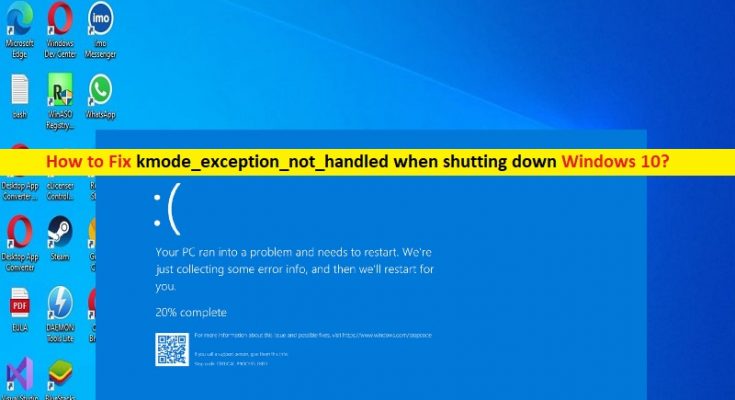Tips to fix kmode_exception_not_handled when shutting down Windows 10:
If you are experiencing kmode_exception_not_handled when shutting down Windows 10, then you are in right-place for the solution. Here, you are provided with easy steps/methods to resolve the issue. Let’s starts the discussion.
‘kmode_exception_not_handled when shutting down Windows 10’: It is common Windows problem considered as BSOD (Blue Screen of Death) error. This error is usually appeared when you start/restart Windows computer or while working on Windows computer. Also, this BSOD error is appeared when you shutting down your Windows 10 computer. The error is appeared with message saying ‘Your PC ran into a problem and needs to restart. We’re just collecting some error info and we’ll restart for you’.
kmode_exception_not_handled BSOD error is occurred possibly due to corruption in system files or registry or in system image, corruption in Windows computer, corrupted hard disk drives and bad hard disk sectors, malware or viruses infections in computer, corrupted/outdated device drivers and other issues. You should make sure all device drivers are properly installed and are up-to-date to latest & compatible version in computer. If not, driver update is necessary for all necessary device hardware in computer.
This issue can also be occurred due to problematic hardware like RAM, hard disk or other hardware attached/integrated into your PC/Laptop. You should make all device hardware that are attached/connected to computer are working fine and there is no any hardware and its connection issue at all. It is possible to fix the issue with our instructions. Let’s go for the solution.
How to fix kmode_exception_not_handled when shutting down Windows 10?
Method 1: Fix kmode_exception_not_handled when shutting down Windows 10 with ‘PC Repair Tool’
‘PC Repair Tool’ is easy & quick way to find and fix BSOD errors, DLL errors, EXE errors, problems with programs/applications, malware or viruses infections in computer, system files or registry issues, and other system issues with just few clicks.
Method 2: Enable Legacy Advanced Boot menu via Command Prompt

Step 1: Restart your computer and when booting initiates, press ‘F2’, ‘Del’ or other BIOS supported key to enter into BIOS mode
Step 2: On you are in BIOS mode, configure the system to boot from DVD/CD drive and save the modified Windows Bootable Installation DVD into the optical media drive DVD/CD drive
Step 3: When ‘Press any key to boot from CD or DVD’ appears, press any key to boot the PC from DVD support
Step 4: Once Windows Setup appears, click ‘Next’ and choose ‘Repair your PC’
Step 5: Now, go to ‘Troubleshoot > Advanced > Command Prompt’, type the following commands and hit ‘Enter’ key to execute.
C:
BCDEDIT / SET {DEFAULT} BOOTMENUPOLICY LEGACY
Step 6: Once executed, exit command prompt and restart your computer normally and check if it works.
Method 3: Run CHKDSK scan
Step 1: Type ‘cmd’ in Windows Search Box and press ‘SHIFT + ENTER’ keys to open ‘Command Prompt as Admisntrator’
Step 2: Type ‘chkdsk /f /r’ command and hit ‘Enter’ key to execute. Once executed, restart your computer and check if the issue is resolved.
Method 4: Run SFC scan
You can run SFC scan in computer to repair corruption in system files in order to fix the issue.
Step 1: Open ‘Command Prompt as Administrator’ using above method
Step 2: Type ‘sfc /scannow’ command and hit ‘Enter’ key to execute. Once executed, restart your computer and check if the issue is resolved.
Method 5: Update Device Drivers in Windows 10
Updating all necessary device drivers to latest & compatible version can resolve the issue. You can update all Windows drivers to latest & compatible version using Automatic Driver Update Tool. You can get this tool through button/link below.
Method 6: Update Windows OS
Updating Windows OS to latest version can resolve the issue.
Step 1: Open ‘Settings’ app in Windows PC and go to ‘Update and Security > Windows Update’ and click ‘Check for updates’ button
Step 2: Download and install all available updates in computer and once updated, restart your computer and check if the issue is resolved.
Method 7: Run Windows Automatic Repair
If the issue is still persist, you can run Windows Automatic Repair to fix the issue.
Step 1: Open ‘Settings’ app in Windows PC and go to ‘Update & Security > Troubleshoot > Advanced Options’ and click ‘Automatic Repair’
Step 2: After troubleshooting, close the tab and check if the issue is resolved.
Method 8: Check any hardware failure issue in Windows 10

Step 1: Press ‘Windows + R’ keys on keyboard, type ‘mdsched.exe’ in ‘Run’ window and hit ‘Ok’ button to start it
Step 2: Wait to finish process and once done, check if the issue is resolved.
Method 9: Run Windows memory diagnostic tool

You can run Windows Memory Diagnostic tool to scan and fix RAM or memory relating issue.
Step 1: Open ‘Windows Memory Diagnostic’ tool in Windows PC via Windows Search Box
Step 2: Click ‘Restart your computer and check of memory problem’ and wait to finish scanning and repairing process and once finished, check if the issue is resolved.
Conclusion
I hope this post helped you on How to fix kmode_exception_not_handled when shutting down Windows 10 with easy ways. You can read & follow our instructions to do so. That’s all. For any suggestions or queries, please write on comment box below.



